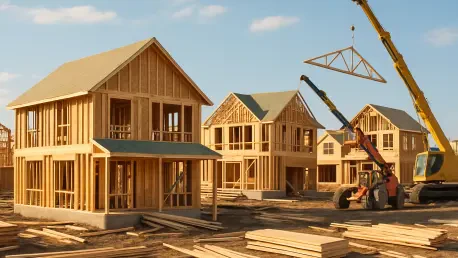In a striking move to address the persistent housing shortage across the nation, President Donald Trump has publicly called on Fannie Mae and Freddie Mac, the two government-sponsored enterprises pivotal to the housing market, to push major homebuilders into accelerating construction efforts. This directive, shared through a detailed post on Truth Social, underscores a growing concern over the staggering number of undeveloped lots—estimated at a record 2 million—sitting idle despite available financing. Trump’s message frames this as a critical step toward reviving the American Dream of homeownership, a theme that has been central to his policy agenda since taking office. With housing affordability and supply emerging as pressing issues for millions of Americans, this call to action raises questions about the role of these entities in directly influencing construction and whether such a strategy can effectively tackle the complex barriers in the market. The urgency of this initiative sets the stage for a deeper exploration of both policy intentions and economic realities.
Addressing the Housing Supply Challenge
The core of Trump’s appeal to Fannie Mae and Freddie Mac lies in the frustration over stagnant homebuilding activity at a time when demand for housing continues to outpace supply. Despite the availability of financing, homebuilders are reportedly hesitant to break ground on the vast number of empty lots they control, contributing to a bottleneck in new housing stock. Trump’s directive suggests that these government-sponsored enterprises should play a more active role in incentivizing construction, though the specific mechanisms for such involvement remain undefined. Historically, Fannie and Freddie have focused on providing liquidity to the mortgage market by purchasing loans from lenders and establishing credit standards, rather than directly engaging with builders. This raises a fundamental question about whether their influence can realistically extend to spurring physical construction or if other policy levers might prove more effective in addressing this supply-side challenge.
Beyond the immediate call for action, the broader context of housing inventory trends paints a sobering picture of the market’s readiness for rapid expansion. Data indicates that while existing home inventory has risen to nearly 864,000 units recently, and new home inventory stands at 490,000 as of the latest reports, there remains a significant overhang of unsold completed units—over 120,000 by some estimates. This high inventory of finished homes acts as a deterrent for builders to issue new permits, as the risk of oversupply looms large. Industry experts argue that without a significant uptick in demand, simply pushing for more construction through entities like Fannie and Freddie may not yield the desired results. Instead, attention must turn to underlying economic factors that influence builder confidence, suggesting that a more holistic approach might be necessary to break the current deadlock in homebuilding activity.
Policy Ambitions and Market Realities
Trump’s focus on housing extends far beyond this recent directive, reflecting a comprehensive agenda aimed at reshaping the sector through aggressive policy moves. Since taking office, the administration has implemented sweeping changes at Fannie and Freddie, including board overhauls, executive dismissals, and significant staff reductions. Policy shifts, such as the adoption of VantageScore 4.0 for credit assessments and the acceptance of crypto-backed mortgages under FHFA Director Bill Pulte, signal a willingness to innovate within the housing finance system. Additionally, there is a renewed push to release these enterprises from conservatorship—a goal that has lingered since Trump’s first term but remains unresolved. These actions, coupled with public pressure on major banks to explore privatization options, highlight a multifaceted strategy to reform housing finance while prioritizing affordability and access for American families.
However, the intersection of these ambitious policies with current market dynamics reveals a complex landscape that may temper expectations for immediate results. Housing experts, including analysts like Logan Mohtashami, emphasize that high inventory levels of completed homes for sale create a disincentive for builders to take on new projects, regardless of Fannie and Freddie’s involvement. A more direct solution, as suggested by some, lies in lowering interest rates to stimulate demand—a policy Trump has pursued by pressuring Federal Reserve Chair Jerome Powell. While this approach could potentially jumpstart construction by making home purchases more accessible, it also underscores the limitations of relying solely on government-sponsored enterprises to drive building activity. The tension between bold policy initiatives and the practical barriers within the housing market remains a defining challenge for this administration’s housing agenda.
Navigating Future Solutions for Housing Growth
Reflecting on the efforts made, Trump’s insistence on leveraging Fannie Mae and Freddie Mac to boost home construction marks a significant moment in the ongoing battle against housing shortages. The administration’s broader reforms, from regulatory overhauls to innovative financing policies, demonstrate a determined push to reshape the landscape of homeownership. Yet, the persistent caution among builders, driven by high unsold inventory, highlights the limits of direct intervention by these enterprises in overcoming market hesitations.
Looking ahead, the path to increasing housing supply appears to hinge on a balanced approach that combines monetary policy adjustments, such as interest rate reductions, with targeted incentives for builders to utilize their undeveloped lots. Collaboration between government entities, financial institutions, and the construction industry could pave the way for innovative solutions that address both supply and demand imbalances. As discussions continue, the focus should remain on creating sustainable conditions for growth, ensuring that the dream of homeownership becomes attainable for more Americans through pragmatic and well-coordinated strategies.









